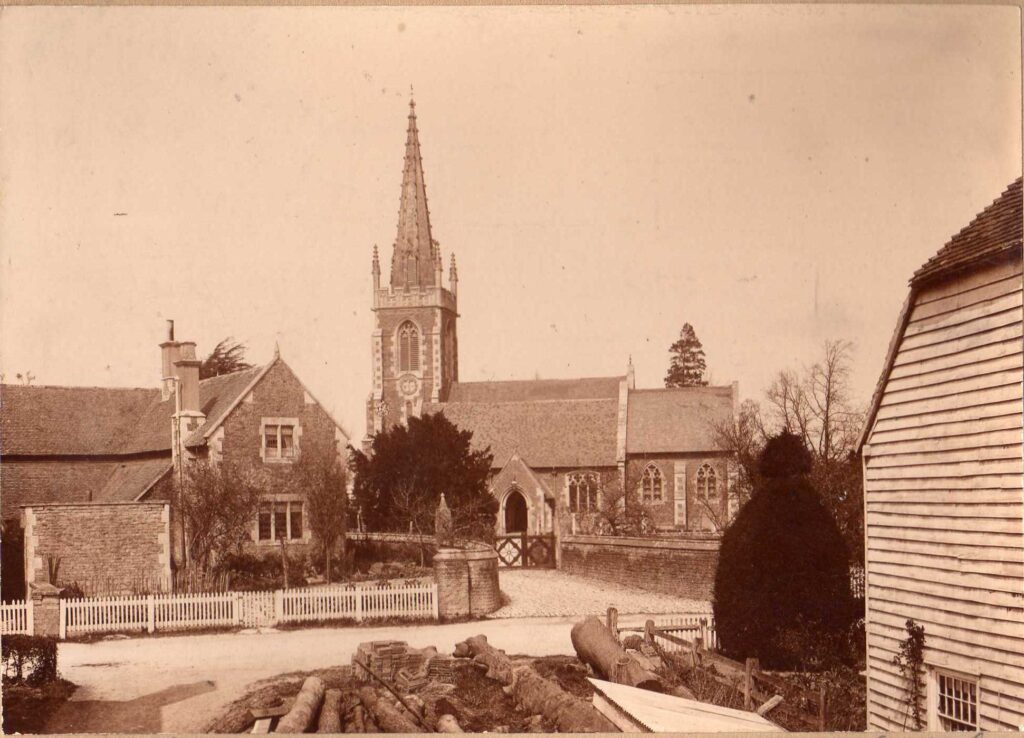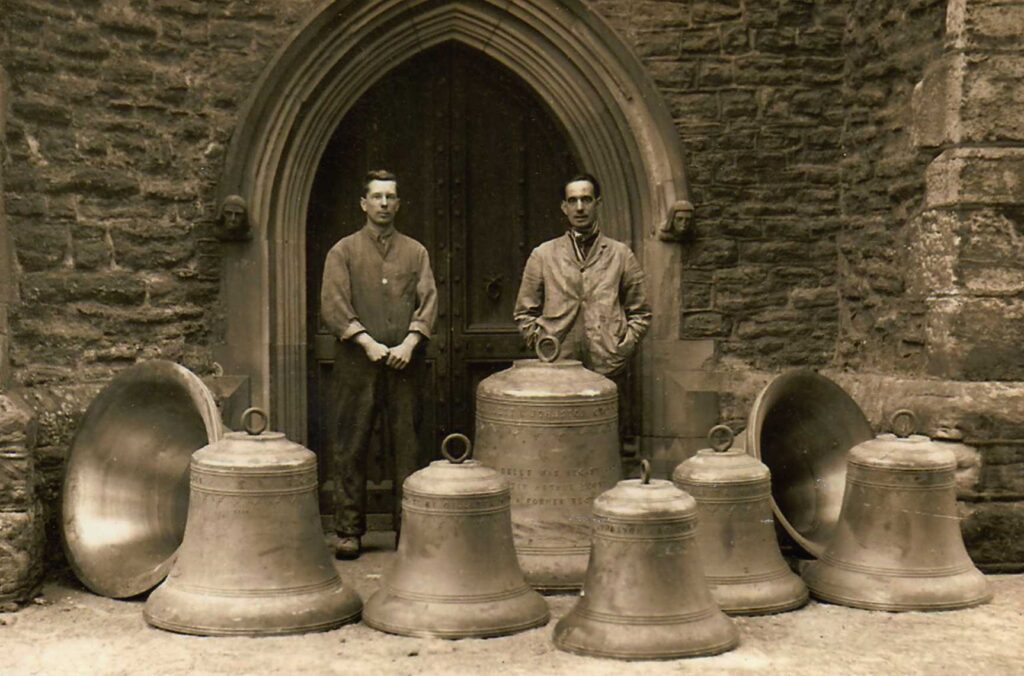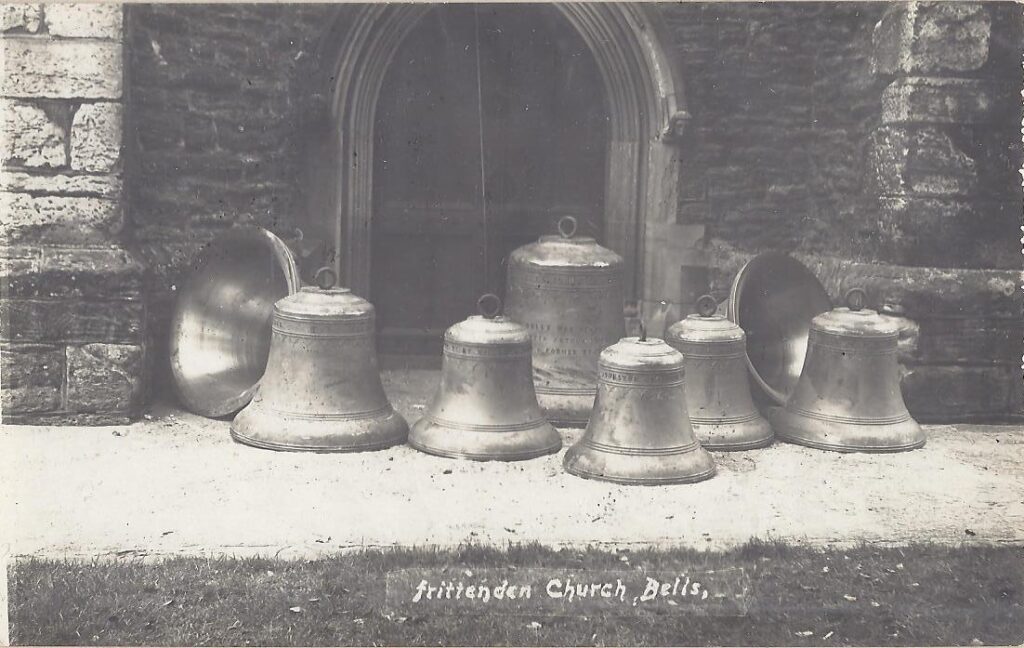Further to Rebecca Steele’s article ‘Oranges and Lemons’ in the September Parish Magazine, I thought it worth giving a short history of Frittenden’s ring of bells. Frittenden has a long record of bell ringing with some notable records and personalities.
Hasted, 1798, records that St Mary’s had a peal of six bells. However, these were shortly to be replaced. Two were dated 1803 and four 1804. Church records show a payment for 6 new bells from Thos. Mears of the Whitechapel Foundry, probably the most eminent foundry in the country at this time. The cost of £353-18-11 was partially offset by the old bells which were valued at £216-8-0.
At the time of the restoration of the church (1846-8) by Edward Moore, the architect, R.C. Hussey, recommended that owing to the building’s poor state it should be taken down almost entirely. The only parts of the church to survive were the nave and the 15th century base of the tower. As part of the rebuilding, two further bells, a treble and a tenor, were commissioned, again from the Whitechapel Foundry.

The first peal of the 8 bells rang out over Frittenden 17 January 1847. This was a 5,040 Bob Major in 2hrs 57mins. It was conducted by Mr James Bourne. The ringers were G. Southon of Benenden, treble; J. Bowles, Frittenden, 2nd; A. Farris, Biddenden, 3rd; G. Landsell, Benenden, 4th; T. Daynes, Frittenden, 5th; J. Hurry, London, 6th; J. Bourne, Biddenden, 7th; E. Wenham, Benenden, tenor.
Another significant ringing was recorded in 1861 when a
‘true and complete’ peal, consisting of 5,760 changes,
Bob Major, with all the eight seven sixes and the six seven
eights of the grand courses of the 40,320 changes,’
This was completed in 3hrs 16 mins. The peal was composed by Thos. Bigg of Otham and conducted by Thos. Daynes. On this occasion all the ringers were from Frittenden including the two Frittenden ringers from the first 1847 peal.
By 1879, Frittenden Church had one of the best Bob Major bands in the country and were among the first ringers to join the Kent County Association of Change Ringers (KCACR). Indeed, the first peal of 5,040 changes of Bob Major by the Association was rung at St Mary’s 31 October 1881.
There was a long tradition of tolling a bell to signify the death of a parishioner. Mary Hallward’s Diary for Wednesday 7th June 1916 records – “ To Church at 8 with Eliza. Tom Hope died, in the [Cranbrook] Union [workhouse], so I rang the bell.”
In June 1928 the bells were removed for tuning and general overhaul. There was some discussion about the necessity of having an iron frame to replace the existing timber frame which was in two independent tiers. After a lengthy dispute with founders John Taylor, the originally accepted tender, the contract work was finally awarded to Gillet and Johnston, founders of Croydon, who agreed to provide a new timber frame. Although the intention had been to recast only the 7th and to overhaul the rest, in fact all the bells were recast.

The last of the bells (2nd and 7th) were tuned in January 1929 and the bells were hung in a new two-tier frame in the tower and dedicated by the Bishop of Dover 21 February of that year.

The cost of this and other essential work in the Church tower, thought to be over £600, was borne by Admiral Sir Arthur Moore, son of the former Rector Edward Moore.
This remains the current ring of 8 bells which range in size from the treble, approx. 4cwt (448 lbs), with a 26 inch diameter, to the tenor, approx. 15cwt (1,680 lbs), at about 43 inches diameter.
There was much press interest in two members of the Frittenden Band in 1934. In that year Mr and Mrs Baker, of Brick Kiln, Frittenden, had achieved the then world record of 200 peals together. Their achievement was widely covered in the press where it was also noted that Mrs Baker’s father, Mr Walter Rofe, was a veteran campanologist of 64 years. Aged 81, he lived at the Lodge Gate, Comenden Manor and still worked as a roadman.

Also reported in August 1934 was a quarter peal of Grandsire Triple (1,260 changes) by the KCACR. The ringers included Mr and Mrs Baker. Conducted by J Head, it was rung in honour of the diamond anniversary of Mr and Mrs Cox of Little Buckhurst Farm who had been married at St Mary’s sixty years previously.
15 November 1942 the church bells were rung in celebration of the victory of the 8th Army over the Germans and Italians in Egypt and Libya. This was the first time that the bells had been rung since the beginning of the War. May 8 1945 at 6pm the bells were rung until 7.30pm to mark the end of WWII in Europe. June 10 1946 was observed as Victory Day and a Victory peal was rung.
Many of the other peals by the Frittenden Band are recorded in the church Bell Tower and in Love’s Guide to the Church Bells of Kent.
Phil Betts, Chairman
(with apologies to David Manger and his band for any misunderstanding of the mysteries of campanology)